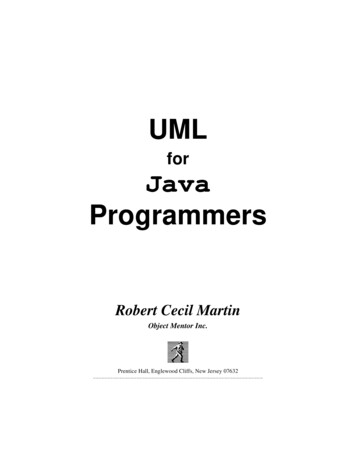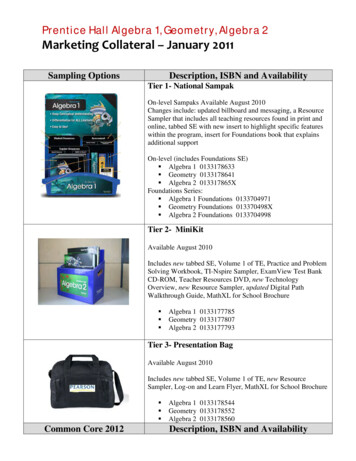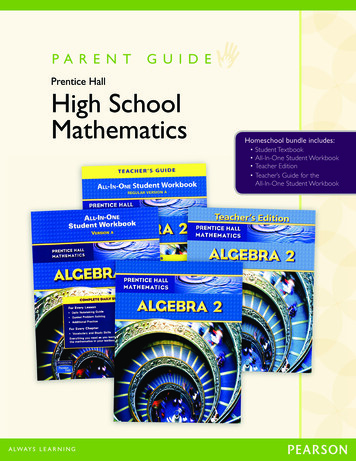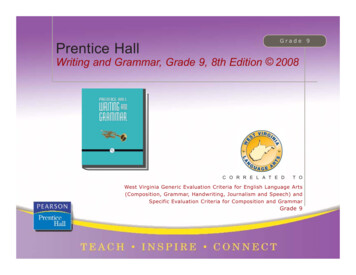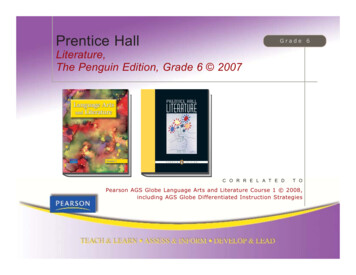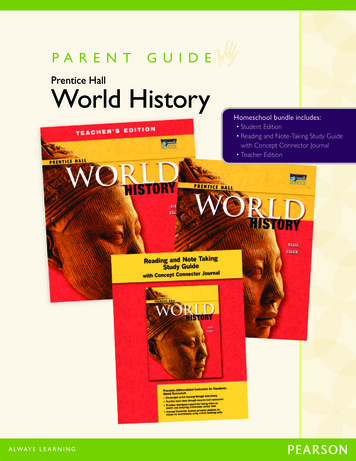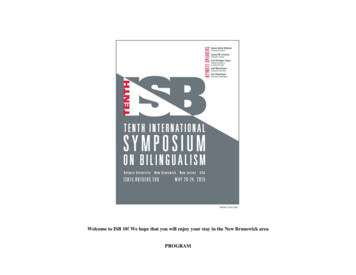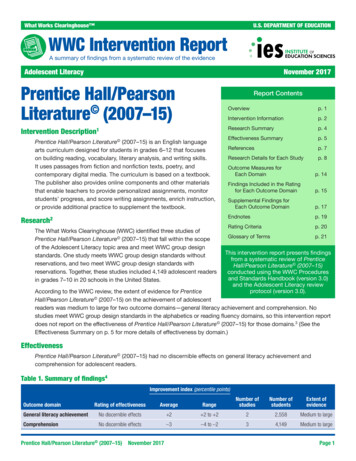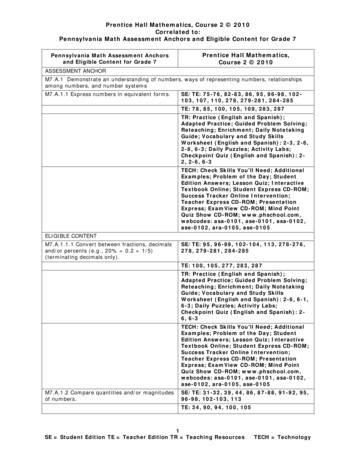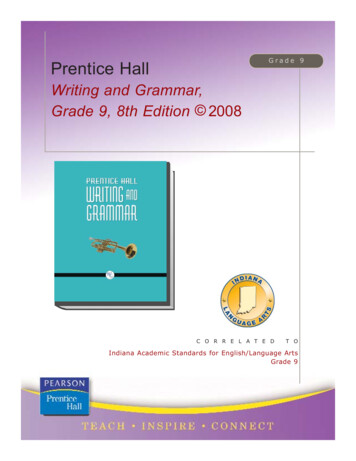
Transcription
Grade 9Prentice HallWriting and Grammar,Grade 9, 8th Edition 2008C O R R E L A T E DT OIndiana Academic Standards for English/Language ArtsGrade 9
Prentice Hall Writing and Grammar, Grade 9, 8E 2008Correlated to:Indiana Academic Standards for English/Language Arts(Grade 9)IN ACADEMIC STANDARDS FORGRADE 9PAGE(S) WHERE TAUGHT(If submission is not a text, citeappropriate resource(s))Grade 9During the high school years, reading, writing, and speaking overlap as students deepen their studyof language and literature and gain skills that help them in other subjects, such as science andhistory. Students intensify their study of vocabulary by interpreting what words imply and applyingtheir knowledge of roots from Greek and Latin to draw inferences about meaning. Students analyzeand evaluate a wide variety of American, English, and world nonfiction and literary texts. Theystudy the important works and authors, poets, and playwrights of various historical periods andcritique their works. High school students become good researchers and write or deliver increasinglysophisticated research reports and multimedia presentations. The ability to develop an idea andexpress it persuasively helps students create strong oral and written skills that they can use incollege and the workplace.Standard 1READING: Word Recognition, Fluency, and Vocabulary DevelopmentStudents apply their knowledge of word origins (words from other languages or from history orliterature) to determine the meaning of new words encountered in reading and use those wordsaccurately.Vocabulary and Concept DevelopmentSE/TE: Figurative Language, 111, 121;9.1.1 Identify and use the literal and figurativemeanings of words and understand the origins of Developing Your Vocabulary, 767–771; StudyingWords Systematically, 772–773; Studying Wordwords.Parts and Origins, 774–777; ExploringEtymologies (Word Origins), 778, 823; also see:Example: Understand figurative language whenExamining the Author’s language, 803;reading text, such as She shot me a glance thatStandardized Test Preparation Workshops:would have made a laser beam seem like anouns in analogies, 358–359birthday candle. (Larry Servais)TR: Teaching Resources: Vocabulary andSpelling Practice Book; Reading Support PracticeBook; Academic and Workplace Skills ActivityBook; Formal AssessmentTECH: Interactive Textbook Online; TeacherExpress CD-ROM, Test Bank CD-ROM; Writers atWork Video Program DVD; Writing and GrammarCompanion Web Site9.1.2 Distinguish between what words meanSE/TE: Denotation/connotation, 130-133literally and what they imply and interpret what(including Reading/Writing Connection:the words imply.Connotations, 130), 166, 770, 803; analogies,358-359, 771, 829; Figurative Language, 111,Example: Analyze both the literal and the121implied meaning of phrases when reading text,such as We had a permissive father. Hepermitted us to work. (Sam Levinson)TR: Teaching Resources: Vocabulary andSpelling Practice Book; Reading Support PracticeBook; Academic and Workplace Skills ActivityBook; Formal AssessmentTECH: Interactive Textbook Online; TeacherExpress CD-ROM, Test Bank CD-ROM; Writers atWork Video Program DVD; Writing and GrammarCompanion Web SiteOpportunities to address this standard can be9.1.3 Use knowledge of mythology (Greek,found on the following pages:Roman, and other mythologies) to understandthe origin and meaning of new words.SE/TE: Exploring Etymologies (Word Origins),1SE Student Edition - TE Teacher Edition - TR Teaching Resources - TECH Technology
Prentice Hall Writing and Grammar, Grade 9, 8E 2008Correlated to:Indiana Academic Standards for English/Language Arts(Grade 9)IN ACADEMIC STANDARDS FORGRADE 9Example: Use the story of Midas to understandthe phrase the Midas touch. Use the story of theIliad and Achilles to understand the phraseAchilles’ heel.PAGE(S) WHERE TAUGHT(If submission is not a text, citeappropriate resource(s))778, 823; Studying Word Parts and Origins,775–777; also see: Cultural context clues ofmyths, 807TR: Teaching Resources: Vocabulary andSpelling Practice Book; Reading Support PracticeBook; Academic and Workplace Skills ActivityBook; Formal AssessmentTECH: Interactive Textbook Online; TeacherExpress CD-ROM, Test Bank CD-ROM; Writers atWork Video Program DVD; Writing and GrammarCompanion Web SiteStandard 2READING: Comprehension and Analysis of Nonfiction and Informational TextStudents read and understand grade-level-appropriate material. The selections in the IndianaReading List (www.doe.state.in.us/standards/readinglist.html) illustrate the quality and complexityof the materials to be read by students. At Grade 9, in addition to regular classroom reading,students read a wide variety of nonfiction, such as biographies, autobiographies, books in manydifferent subject areas, essays, speeches, magazines, newspapers, reference materials, technicaldocuments, and online information.Structural Features of Informational and Technical Materials9.2.1 Analyze the structure and format ofSE/TE: Workplace Writing, 326–327, 328–329,reference or functional workplace documents,330–331; Interpreting Maps and Graphs, 752–754; Reading Nonfiction Critically, 798-803,including the graphics and headers, and explainReading from Varied Sources, 808–809;how authors use the features to achieve theirReference Skills, 816–826; Standardized Testpurposes.Preparation Workshops: constructing meaningfrom informational texts, 832–833, readingExample: After collecting samples of severalinformational texts, 846–847; also see:different applications for employment fromInternet: consumer reports on, 197, electronicdifferent area employers, evaluate whatcalendar on, 842, library access on, budgetinginformation the applications ask for and whatsites on, 844; Research Paper: Conductthis suggests about the skills the employers arePreliminary Research, 258-259, Locate Sources,looking for in an applicant.260, Use a Variety of Outside Sources, 263,Write a Reference List, 268; Reading Skills:Evaluating Nonfiction, 798, Evaluating What YouRead, 799–800, Internet Research Handbook:researching on, 887–8899.2.2 Prepare a bibliography of referencematerials for a report using a variety of publicdocuments, such as consumer, government,workplace and others.Example: Prepare a bibliography citing a wideTR: Teaching Resources: Reading SupportPractice Book; Vocabulary and Spelling PracticeBook; Academic and Workplace Skills ActivityBook; Formal AssessmentTECH: Interactive Textbook Online; TeacherExpress CD-ROM, Test Bank CD-ROM; Writers atWork Video Program DVD; Writing and GrammarCompanion Web SiteSE/TE: Bibliographies: annotated, 251,conventions for writing, 268-269, textbook,791; also see:References: incorporating, 292, types of, 695;Write a Reference List, 268; Citing Sources,880–8862SE Student Edition - TE Teacher Edition - TR Teaching Resources - TECH Technology
Prentice Hall Writing and Grammar, Grade 9, 8E 2008Correlated to:Indiana Academic Standards for English/Language Arts(Grade 9)IN ACADEMIC STANDARDS FORGRADE 9PAGE(S) WHERE TAUGHT(If submission is not a text, citeappropriate resource(s))variety of consumer, workplace, and publicdocuments for a report on labor laws for childrenor for a report on the history and future ofAmerican innovation and invention.TR: Teaching Resources: Reading SupportPractice Book; Vocabulary and Spelling PracticeBook; Academic and Workplace Skills ActivityBook; Formal AssessmentTECH: Interactive Textbook Online; TeacherExpress CD-ROM, Test Bank CD-ROM; Writers atWork Video Program DVD; Writing and GrammarCompanion Web SiteAnalysis of Grade-Level-Appropriate Nonfiction and Informational Text9.2.3 Generate relevant questions aboutSE/TE: Research Paper: Choosing Your Topic,readings on issues or topics that can be256-257, Conduct Preliminary Research, 258,researched.Match Your Purpose with Research, 259, LocateSources, 260, Propose a Thesis Statement, 261,Example: Read about some of the differentUse a Variety of Outside Sources, 263, Write acultures described in African Beginnings byReference List, 268; Using the SQ4R Method,James Haskins, Kathleen Benson, and Floyd793–794; Reading Skills: Evaluating Nonfiction,Cooper. Generate researchable questions about798, Evaluating What You Read, 799–800,how and why the cultures developed asEvaluating Modes of Reasoning, 801–802differently as they did.TR: Teaching Resources: Reading SupportPractice Book; Vocabulary and Spelling PracticeBook; Academic and Workplace Skills ActivityBook; Formal AssessmentTECH: Interactive Textbook Online; TeacherExpress CD-ROM, Test Bank CD-ROM; Writers atWork Video Program DVD; Writing and GrammarCompanion Web Site9.2.4 Synthesize the content from severalSE/TE: Research Paper, 250-279, includingsources or works by a single author dealing withGathering Information, 260, Propose a Thesisa single issue; paraphrase the ideas and connect Statement, 261, Refine Your Thesis Statement,them to other sources and related topics to264; also see: Response to Literature, 280–281,demonstrate comprehension.282–285, 286–290, 291–292, 293–297, 298,299–302; also see: Spotlight on the HumanitiesExample: Read three or more nonfiction textsActivities, 8, 24, 44, 70, 96, 124, 152, 172, 198,about black holes: Black Holes by Heather224, 246, 276, 304, 320, 334; Responding toCouper et al.; Black Holes by Jean-PierreFine Art and Literature, 55, 79, 107, 135, 159,Luminet et al.; articles identified using the181, 207, 233, 257; Letter to an Author, 287;Reader’s Guide to Periodical Literature; or anExposition: Comparison–and–Contrast Essay,online database of articles. Take notes that176–177, 178–179, 180–183, 184–185, 186–describe black holes and identify quotes that can 190, 191, 192–195be used in writing a paper that cites the sources.TR: Teaching Resources: Reading SupportPractice Book; Vocabulary and Spelling PracticeBook; Academic and Workplace Skills ActivityBook; Formal AssessmentTECH: Interactive Textbook Online; TeacherExpress CD-ROM, Test Bank CD-ROM; Writers atWork Video Program DVD; Writing and Grammar3SE Student Edition - TE Teacher Edition - TR Teaching Resources - TECH Technology
Prentice Hall Writing and Grammar, Grade 9, 8E 2008Correlated to:Indiana Academic Standards for English/Language Arts(Grade 9)IN ACADEMIC STANDARDS FORGRADE 99.2.5 Demonstrate use of technology byfollowing directions in technical manuals.Example: Locate and follow the directionsembedded in word processing help menus forformatting text paragraphs, such as hangingindents.9.2.8 Make reasonable statements and drawconclusions about a text, supporting them withaccurate examples.PAGE(S) WHERE TAUGHT(If submission is not a text, citeappropriate resource(s))Companion Web SiteSE/TE: Media and Technology Skills:introduction to, 9, building electronic portfolio,25, exploring communication technology, 45,word processing, 173, 247, 335, usingcomputerized test banks, 321, library access on,816, 817, electronic databases on, 818,dictionaries on, 823, using, 826, budgeting siteson, 844, electronic calendar on, 842; InternetResearch Handbook: researching on, 887–889TR: Teaching Resources: Reading SupportPractice Book; Vocabulary and Spelling PracticeBook; Academic and Workplace Skills ActivityBook; Formal AssessmentTECH: Interactive Textbook Online; TeacherExpress CD-ROM, Test Bank CD-ROM; Writers atWork Video Program DVD; Writing and GrammarCompanion Web SiteSE/TE: Response to Literature, 280–281, 282–285, 286–290, 291–292, 293–297, 298, 299–302; Reading Skills: Evaluating Nonfiction, 798,Evaluating What You Read, 799–800, EvaluatingModes of Reasoning, 801–802; StandardizedTest Preparation Workshops: questions aboutshort stories, 98–99, responding to literature–based prompts, 306–307, constructing meaningfrom informational text, 832–833, inferencesand predictions, 810–811, reading informationaltexts, 846–847; Reading ComprehensionQuestions, 849–855; also see:Reading–Writing Connections: distinguishingfact and opinion, 50, identifying audience, 178,identifying main idea, 204, evaluating ideas,252, evaluating opinions, 282TR: Teaching Resources: Reading SupportPractice Book; Vocabulary and Spelling PracticeBook; Academic and Workplace Skills ActivityBook; Formal Assessment4SE Student Edition - TE Teacher Edition - TR Teaching Resources - TECH Technology
Prentice Hall Writing and Grammar, Grade 9, 8E 2008Correlated to:Indiana Academic Standards for English/Language Arts(Grade 9)TECH: Interactive Textbook Online; TeacherExpress CD-ROM, Test Bank CD-ROM; Writers atWork Video Program DVD; Writing and GrammarCompanion Web SiteExpository (Informational) Critique9.2.6 Critique the logic of functional documents(such as an appeal to tradition or an appeal toforce) by examining the sequence of informationand procedures in anticipation of possible readermisunderstandings.Example: Evaluate a document that gives a setof expectations and rules for behavior. This couldbe a school’s code of ethics, an extracurricularorganization’s constitution and bylaws, or itcould be a set of local, state, or federal laws.Evaluate the way the document is written andwhether the expectations for readers are clear.SE/TE: Reading Skills: Evaluating Nonfiction,798, Evaluating What You Read, 799–800,Evaluating Modes of Reasoning, 801–802;Standardized Test Preparation WorkshopReading Informational Texts, 846-847;Workplace Writing: Meeting Minutes, 328–329,Forms and Applications, 330–331; Speaking andListening Skills: using critical listening, 749–751; learning teamwork, 837–838TR: Teaching Resources: Reading SupportPractice Book; Vocabulary and Spelling PracticeBook; Academic and Workplace Skills ActivityBook; Formal Assessment5SE Student Edition - TE Teacher Edition - TR Teaching Resources - TECH Technology
Prentice Hall Writing and Grammar, Grade 9, 8E 2008Correlated to:Indiana Academic Standards for English/Language Arts(Grade 9)9.2.7 Evaluate an author’s argument or defenseof a claim by examining the relationship betweengeneralizations and evidence, thecomprehensiveness of evidence, and the way inwhich the author’s intent affects the structureand tone of the text.Example: Analyze the language and images usedin print advertisements or electronic media andevaluate how the advertisement is written anddesigned to convince a potential customer to usea product.TECH: Interactive Textbook Online; TeacherExpress CD-ROM, Test Bank CD-ROM; Writers atWork Video Program DVD; Writing and GrammarCompanion Web SiteSE/TE: Reading Skills: Evaluating Nonfiction,798, Evaluating What You Read, 799–800,Evaluating Modes of Reasoning, 801–802;Reference Skills: Evaluating Web Sites, 826;also see: Reading–Writing Connections:distinguishing fact and opinion, 50-53,identifying support, 230, evaluating ideas, 252255, evaluating opinions, 282-285;Standardized Test Preparation Workshops:Constructing Meaning from Informational Texts,832–833, Reading Informational Texts, 846–847TR: Teaching Resources: Reading SupportPractice Book; Vocabulary and Spelling PracticeBook; Academic and Workplace Skills ActivityBook; Formal AssessmentTECH: Interactive Textbook Online; TeacherExpress CD-ROM, Test Bank CD-ROM; Writers atWork Video Program DVD; Writing and GrammarCompanion Web SiteStandard 3READING: Comprehension and Analysis of Literary TextStudents read and respond to grade-level-appropriate historically or culturally significant works ofliterature, such as the selections in the Indiana Reading ), which illustrate the quality and complexity of thematerials to be read by students. At Grade 9, students read a wide variety of literature, such asclassic and contemporary literature, historical fiction, fantasy, science fiction, folklore, mythology,poetry, short stories, dramas, and other genres.Structural Features of LiteratureOpportunities to address this standard can be9.3.1 Explain the relationship between thefound on the following pages:purposes and the characteristics of differentforms of dramatic literature (including comedy,tragedy, and dramatic monologue).SE/TE: Reading Drama, 806; Response toLiterature, 280-307, also see: DramaticExample: Compare plays with similar themes,interpretations, presenting, 763such as the theme of prejudice in Twelve AngryMen by Reginald Rose and The King and I byRichard Rodgers and Oscar Hammerstein II.TR: Teaching Resources: Reading SupportPractice Book; Vocabulary and Spelling PracticeBook; Academic and Workplace Skills ActivityBook; Formal AssessmentTECH: Interactive Textbook Online; TeacherExpress CD-ROM, Test Bank CD-ROM; Writers atWork Video Program DVD; Writing and GrammarCompanion Web SiteOpportunities to address this standard can be9.3.2 Compare and contrast the presentation offound on the following pages:a similar theme or topic across genres (differenttypes of writing) to explain how the selection ofSE/TE: Response to Literature, 280-307genre shapes the theme or topic.Spotlight on the Humanities: recognizing6SE Student Edition - TE Teacher Edition - TR Teaching Resources - TECH Technology
Prentice Hall Writing and Grammar, Grade 9, 8E 2008Correlated to:Indiana Academic Standards for English/Language Arts(Grade 9)Example: Consider the theme of the relationshipbetween nature and humans. Read differentworks on the theme, including a poem praisingthe beauty of nature (such as John GreenleafWhittier’s “Snowbound”), a novel in whichelements of nature play a large role (such as MyAntonia by Willa Cather), or a play (such asShakespeare’s The Tempest).themes, 24, 44, 70, 96, 124, 172, 276, 320,analyzing themes in art forms, 304TR: Teaching Resources: Reading SupportPractice Book; Vocabulary and Spelling PracticeBook; Academic and Workplace Skills ActivityBook; Formal AssessmentTECH: Interactive Textbook Online; TeacherExpress CD-ROM, Test Bank CD-ROM; Writers atWork Video Program DVD; Writing and GrammarCompanion Web SiteAnalysis of Grade-Level-Appropriate Literary Text9.3.3 Analyze interactions between characters ina literary text and explain the way thoseinteractions affect the plot.SE/TE: Response to Literature, 280-307, alsosee: Character Studies, 81, 281, 290;Characters, Action, 805, 806Example: Discuss the development of thedifferent characters in Charles Dickens’ GreatExpectations.9.3.4 Determine characters’ traits by what thecharacters say about themselves in narration,dialogue, and soliloquy (when they speak outloud to themselves).TE: Customize for more advanced students,essay on a character, 805TR: Teaching Resources: Reading SupportPractice Book; Vocabulary and Spelling PracticeBook; Academic and Workplace Skills ActivityBook; Formal AssessmentTECH: Interactive Textbook Online; TeacherExpress CD-ROM, Test Bank CD-ROM; Writers atWork Video Program DVD; Writing and GrammarCompanion Web SiteSE/TE: Response to Literature, 280-307; alsosee: Models from Literature, 76-78,Characterization, 76–77; Character Studies, 81,281, 290; Characters, Action, 805, 806Example: Read works, such as The Secret Diaryof Adrian Mole, Aged 13 3 4 by Sue Townsend orSpoon River Anthology by Edgar Lee Masters,and describe the characters, citing specificexamples from the text to support thisdescription.TE: Customize for more advanced students,essay on a character, 805TR: Teaching Resources: Reading SupportPractice Book; Vocabulary and Spelling PracticeBook; Academic and Workplace Skills ActivityBook; Formal AssessmentTECH: Interactive Textbook Online; TeacherExpress CD-ROM, Test Bank CD-ROM; Writers atWork Video Program DVD; Writing and GrammarCompanion Web Site7SE Student Edition - TE Teacher Edition - TR Teaching Resources - TECH Technology
Prentice Hall Writing and Grammar, Grade 9, 8E 2008Correlated to:Indiana Academic Standards for English/Language Arts(Grade 9)9.3.5 Compare works that express a universaltheme and provide evidence to support theviews expressed in each work.Example: Analyze and compare selections fromRussell Baker’s Growing Up, Ed McClanahan’sNatural Man, and Reynolds Price’s Long andHappy Life as variations on a theme.9.3.6 Analyze and trace an author’s developmentof time and sequence, including the use ofcomplex literary devices, such as foreshadowing(providing clues to future events) or flashbacks(interrupting the sequence of events to includeinformation about an event that happened in thepast).Opportunities to address this standard can befound on the following pages:SE/TE: Reading Literary Writings 804-809,Response to Literature, 280-307 including,Responding to Literature, 287, Use HexagonalWriting to Narrow a Topic, 288, Spotlight on theHumanities: recognizing themes, 44, analyzingthemes in art forms, 304TR: Teaching Resources: Reading SupportPractice Book; Vocabulary and Spelling PracticeBook; Academic and Workplace Skills ActivityBook; Formal AssessmentTECH: Interactive Textbook Online; TeacherExpress CD-ROM, Test Bank CD-ROM; Writers atWork Video Program DVD; Writing and GrammarCompanion Web SiteOpportunities to address this standard can befound on the following pages:SE/TE: Response to Literature, 280-307,Models from Literature, 50-53, 76-78, Plots, infiction, 805; also see: summarizing, 80, trackingconflict in, 84Example: Discuss how Tennessee Williams usesshifts between narration and “in-scene”characters to tell the story in his play The GlassMenagerie.9.3.7 Recognize and understand the significanceof various literary devices, including figurativelanguage, imagery, allegory (the use of fictionalfigures and actions to express truths abouthuman experiences), and symbolism (the use ofa symbol to represent an idea or theme), andexplain their appeal.Example: Analyze and compare figurativelanguage in The Odyssey.TR: Teaching Resources: Reading SupportPractice Book; Vocabulary and Spelling PracticeBook; Academic and Workplace Skills ActivityBook; Formal AssessmentTECH: Interactive Textbook Online; TeacherExpress CD-ROM, Test Bank CD-ROM; Writers atWork Video Program DVD; Writing and GrammarCompanion Web SiteOpportunities to address this standard can befound on the following pages:SE/TE: Model from Literature, 102-105Response to Literature, 280-307; also see:Responding to Fine Art and Literature, 79, 107,135, 207, 233, 257; Response to Literature,280–281, 286–290, 291–292TR: Teaching Resources: Reading SupportPractice Book; Vocabulary and Spelling PracticeBook; Academic and Workplace Skills ActivityBook; Formal AssessmentTECH: Interactive Textbook Online; TeacherExpress CD-ROM, Test Bank CD-ROM; Writers atWork Video Program DVD; Writing and GrammarCompanion Web Site8SE Student Edition - TE Teacher Edition - TR Teaching Resources - TECH Technology
Prentice Hall Writing and Grammar, Grade 9, 8E 2008Correlated to:Indiana Academic Standards for English/Language Arts(Grade 9)9.3.8 Interpret and evaluate the impact ofambiguities, subtleties, contradictions, andironies in a text.Example: After reading The Bridge of San LuisRey by Thornton Wilder or “The Monkey’s Paw”by W.W. Jacobs or “The Necklace” by Guy deMaupassant, discuss the ironies revealed by thestory.9.3.9 Explain how voice and the choice of anarrator affect characterization and the tone,plot, and credibility of a text.Example: Read To Kill a Mockingbird by HarperLee and discuss the impact of Scout’s narrationas the story unfolds.Opportunities to address this standard can befound on the following pages:SE/TE: What is a Short Story, 75, Model fromLiterature, 76, 230-231, Response to Literature,280–281, 282–285, 286–290, 291–292, 293–297, 298, 299–302; Reading Skills: in literarywriting, 804–807; also see: Standardized TestPreparation Workshops: questions about shortstories, 98–99, responding to literature–basedprompts, 306–307, constructing meaning fromtext, 832–833, inferences and predictions, 810–811TR: Teaching Resources: Reading SupportPractice Book; Vocabulary and Spelling PracticeBook; Academic and Workplace Skills ActivityBook; Formal AssessmentTECH: Interactive Textbook Online; TeacherExpress CD-ROM, Test Bank CD-ROM; Writers atWork Video Program DVD; Writing and GrammarCompanion Web SiteSE/TE: Narrators, types of, in storytelling, 8288; Characterization, 76–77; Character Studies,81, 281, 290; Response to Literature, 280-307,Characters, Action, 805, 806TR: Teaching Resources: Reading SupportPractice Book; Vocabulary and Spelling PracticeBook; Academic and Workplace Skills ActivityBook; Formal AssessmentTECH: Interactive Textbook Online; TeacherExpress CD-ROM, Test Bank CD-ROM; Writers atWork Video Program DVD; Writing and GrammarCompanion Web Site9SE Student Edition - TE Teacher Edition - TR Teaching Resources - TECH Technology
Prentice Hall Writing and Grammar, Grade 9, 8E 2008Correlated to:Indiana Academic Standards for English/Language Arts(Grade 9)9.3.10 Identify and describe the function ofdialogue, soliloquies, asides, character foils, andstage designs in dramatic literature. Dialogue: a conversation between twocharacters Soliloquies: long speeches in whichcharacters, on stage alone, reveal innerthoughts aloud Asides: words spoken by characters directlyto the audience Character foils: characters who are used ascontrast to another character Stage designs: directions and drawings forthe setting of a playOpportunities to address this standard can befound on the following pages:SE/TE: Models from Literature, 76-77, Drama,94–95, 806; Response to Literature, 280-307,also see: Dramatic interpretations, presenting,763Example: Define different dramatic literary termsin Shakespeare’s Romeo and Juliet. Describe thefunction that these devices play to expound onplot, advance the action of the story, and revealadditional information about the characters.TR: Teaching Resources: Reading SupportPractice Book; Vocabulary and Spelling PracticeBook; Academic and Workplace Skills ActivityBook; Formal Assessment10SE Student Edition - TE Teacher Edition - TR Teaching Resources - TECH Technology
Prentice Hall Writing and Grammar, Grade 9, 8E 2008Correlated to:Indiana Academic Standards for English/Language Arts(Grade 9)TECH: Interactive Textbook Online; TeacherExpress CD-ROM, Test Bank CD-ROM; Writers atWork Video Program DVD; Writing and GrammarCompanion Web SiteLiterary Criticism9.3.11 Evaluate the aesthetic qualities of style,including the impact of diction and figurativelanguage on tone, mood, and theme.Example: Read one of the stories by Edgar AllanPoe, such as “The Cask of Amontillado,” tounderstand how Poe creates a sense of eerieforeboding.9.3.12 Analyze the way in which a work ofliterature is related to the themes and issues ofits historical period.Example: Read selections that are connected toa certain period in history, such as “The Legendof Sleepy Hollow” by Washington Irving and OurTown by Thornton Wilder. Describe the role thatthe time period plays in these works and analyzethe author’s perspective on the period.9.3.13 Explain how voice, persona, and thechoice of narrator affect the mood, tone, andmeaning of text.SE/TE: Developing Style, 42; Models FromLiterature: Short Story, 76–77, 102-105;Figurative Language, 111, 120-121; Responseto Literature, 280-307, Reading Skills: in literarywriting, 804–807; also see: Responding to FineArt and Literature, 55, 107, 135, 159, 181, 207,233, 257, Student Work In Progress, 300-301,Spotlight on the Humanities: 24, 44, 70, 96,124, 172, 198, 224, 276, 304, 320TR: Teaching Resources: Reading SupportPractice Book; Vocabulary and Spelling PracticeBook; Academic and Workplace Skills ActivityBook; Formal AssessmentTECH: Interactive Textbook Online; TeacherExpress CD-ROM, Test Bank CD-ROM; Writers atWork Video Program DVD; Writing and GrammarCompanion Web SiteSE/TE: Historical Context, 804; CulturalContext, 807; also see: Spotlight on theHumanities: recognizing themes, 44, analyzingthemes in art forms, 304; Writers in Action, 49,75, 101, 129, 157, 177, 203, 229, 251, 281,309; Models From Literature, 50–53, 76–77,102–105, 130–133, 158, 204–205, 230–231,252–255, 282–285, Response to Literature,280-307TR: Teaching Resources: Reading SupportPractice Book; Vocabulary and Spelling PracticeBook; Academic and Workplace Skills ActivityBook; Formal AssessmentTECH: Interactive Textbook Online; TeacherExpress CD-ROM, Test Bank CD-ROM; Writers atWork Video Program DVD; Writing and GrammarCompanion Web SiteSE/TE: Narrators, types of, in storytelling, 82;also see: Characterization, 76–77; CharacterStudies, 81, 281, 290; Response to Literature,280-307, Characters, Action, 805, 806TR: Teaching Resources: Reading SupportPractice Book; Vocabulary and Spelling PracticeBook; Academic and Workplace Skills ActivityBook; Formal AssessmentTECH: Interactive Textbook Online; TeacherExpress CD-ROM, Test Bank CD-ROM; Writers atWork Video Program DVD; Writing and GrammarCompanion Web SiteStandard 4WRITING: Processes and Features11SE Student Edition - TE Teacher Edition - TR Teaching Resources - TECH Technology
Prentice Hall Writing and Grammar, Grade 9, 8E 2008Correlated to:Indiana Academic Standards for English/Language Arts(Grade 9)Students discuss ideas for writing with other writers. They write coherent and focused essays thatshow a well-defined point of view and tightly reasoned argument. Students progress through thestages of the writing process (prewriting, writing, editing, and revising).Organization and Focus9.4.1 Discuss ideas for writing with classmates,SE/TE: Choosing Your Topic, 106 , 134 , 159 ,teachers, and other writers and develop drafts286; Peer review, 6, 25, 64, 88, 111, 117, 145,alone and collaboratively.166, 190, 216, 240, 267, 297, 774; also see:Drafting, 58–59, 82–83, 110–111, 139–140,163, 184–185, 210–211, 236–237, 261–263,291–292, 312–313TR: Teaching Resources: Writing SupportTransparencies; Extra Grammar and WritingExercises; Formal AssessmentTECH: Interactive Textbook Online; TeacherExpress CD-ROM, Test Bank CD-ROM; Writers atW
Prentice Hall Grade 9 Writing and Grammar, Grade 9, 8th Edition 2008 . of language and literature and gain skills that help them in other subjects, such as science and . (Grade 9) TECH: Interactive Textbook Online
